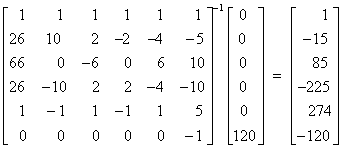From the Geometric Series to Stirling Numbers
The geometric series
![]()
with |x| < 1 can be written in the form
![]()
Differentiating with respect to x gives
![]()
The numerator inside the parentheses is a polynomial of degree 1 in n with coefficients that are functions of x. Letting p1(n,x) denote this polynomial, the above identity can be written as
![]()
In general, given a relation of the form
![]()
where k is a positive integer and pk(n,x) is a polynomial of degree k in n with coefficients that are functions of x, we can differentiate with respect to x to give

The numerator of the coefficient of xn in this summation is a polynomial of degree k+1 in n, so we will denote it by pk+1. Thus we can define an infinite family of polynomials by means of the recurrence
![]()
The first several polynomials of this form are

Notice that these expressions contain the sub-polynomials

We will denote the kth such polynomial by sk(n), the roots of which are the integers 1 through k. Thus for all k > 1 we see that the first term of pk vanishes for n equal to 0, 1,.., k-1, whereas the second term vanishes for n equal to 0, 1,.., k-2, and for n = k-1 the second term equals -(k!)x. This leads us to split the summation in equation (1) into two parts, as shown below
![]()
The first summation is simply -k!, independent of x, so we have
![]()
If we add k to each appearance of n in the summand, we can change the indices so they range from 0 to infinity. Thus we have
![]()
Letting Pk(n,x) denote pk(n+k,x), we can write
![]()
where

The coefficients of x in these expressions are actually the same polynomials as the "constant" coefficients, except n is replaced by n+1. Therefore, in terms of the polynomials
![]()
we can write the general expression for Pk(n,x) in the form
![]()
Obviously we have rk(n) = (-1)ksk(-n). The coefficients of the first several polynomials sk are shown below.

Letting Sk,j denote the jth number in the kth row, the magnitude of Sk,j is the sum of all products of j of the first k positive integers (with the convention that the null product is 1). Obviously we have Sk,k = k!, and we have the generating function
![]()
It follows that the numbers Sk,j satisfy the recurrence relation
![]()
which corresponds to the fact that the sk polynomials satisfy the relation sk(n+1) = nsk-1(n). The numbers Sk,j are essentially Stirling numbers of the first kind. These numbers were named for James Stirling (1692-1770), a Scotsman who is also remembered for the approximate formula for factorials
![]()
that appeared in his book Methodus differentialis on series and interpolation. Stirling was a follower of Newton, and elaborated Newton's scheme for classifying the cubics. He also worked on the problem of determining the earth's shape, agreeing with Newton that the earth bulges at the equator (contrary to Cassini's claim). Later, Stirling became manager of the Scottish Mining Company, a demanding job which made it difficult for him to continue with the study of mathematics and physics. For example, he felt compelled to let lapse a correspondence with Euler, since his work at the mining company prevented him from keeping up with the discussion of Euler's "many ingenious results", "for after deliberations have been interrupted ... patience is required before the mind can be brought to think about the same things once again". In terms of the usual nomenclature and indexing conventions for the Stirling number denoted by Sk(j) we have
![]()
Speaking of Euler, there is a clear relation between Stirling numbers and the Eulerian numbers. As explained in the note on Generalized Eulerian Numbers, we have the identity

where Ek,j are the Eulerian Numbers. Thus we have

These identities can be used to determine the coefficients of a polynomial pk(n) of degree k such that
![]()
For example, with k = 2 we seek constant coefficients A, B, C such that
![]()
Splitting up the summation by powers of n, and making use of the first three Eulerian identities, we have

Simplifying this relation, we find that it is satisfied if and only if
![]()
Since we seek a solution that is valid for arbitrary values of x, each of the quantities in parentheses must vanish, so we have thee equations in three unknowns, which can be solved to give

In the same way we can determine that the polynomials pk(n) for any degree k are just the Stirling polynomials sk(n) discussed previously, i.e., we have
![]()
This is a nice generalization of the geometric series. To illustrate, with k = 4 we have the identity
![]()
Our derivation was explicitly based on the case k = 2, but it's interesting to examine the system of equations for higher degrees. With k = 3 the system of equations is

With k = 4 the system of equations is

As a last example, we show the system of equations with k = 5

The left-most column of the coefficient matrix is a row of the Eulerian numbers, the two right-most columns of the coefficient matrix are rows of the binomial coefficients, and the right-hand column vector is a row of Stirling numbers (of the first kind). Notice that the rows of each of these kinds of numbers sum to factorials if we take their absolute values. On the other hand, with alternating signs each row of binomial or Stirling numbers sums to zero.
It's interesting to review the basic recurrences defining the binomial coefficients, the two kinds of Stirling numbers, and the Eulerian numbers. These are summarized below, with indices signifying left and right diagonal slices beginning with A(1,1) = 1.



